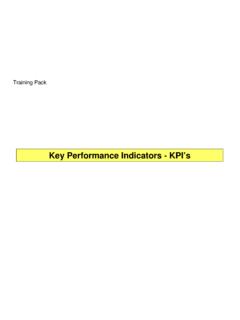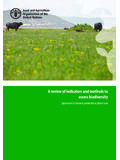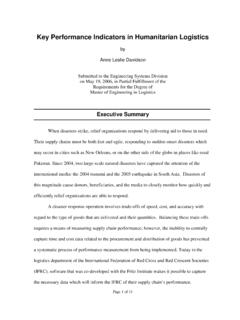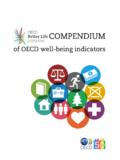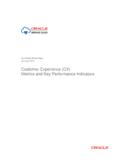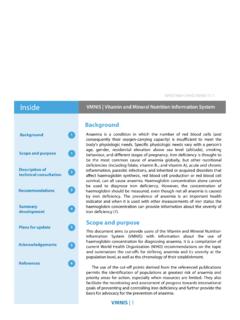Transcription of FAO AND THE SDGs
1 FAO AND. THE sdgs Indicators: Measuring up to the 2030 Agenda for Sustainable Development fao and the sdgs KENYA. CONTENTS. Farmer transplanting rice as part of a farmer field school pilot project. FAO/A. Vitale PAGE 4 PAGES 22-23. INTRODUCTION THE SPICE OF LIFE. PAGE 5 INDICATORS AND A MEASURE OF PAGES 24-25. ACHIEVEMENT REAP WHAT. PAGES 6-7 YOU SOW. SUPPORTING indicator COUNTRIES. PAGES 26-27. PAGE 8. STABILITY. KEY MESSAGES. AND SECURITY. PAGE 9. indicator THE DATA REVOLUTION. PAGES 28-29. PAGES FROM 10 TO 13. EMBRACING AGENTS OF CHANGE. TECHNOLOGY INDICATORS AND PAGE 14 PAGES 30-31. FAO CUSTODIANSHIP EVERY DROP COUNTS. INDICATORS TABLE INDICATORS AND PAGE 15 PAGES 32-33. BRINGING WASTE NOT, NUMBERS TO LIFE WANT NOT. 12 AREAS OF FAO FOCUS indicator IN MONITORING THE sdgs PAGES 34-35. PAGES 16-17 A SEA OF. TOWARDS OPPORTUNITY.
2 ZERO HUNGER INDICATORS , , INDICATORS AND AND PAGES 18-19 PAGES 36-37. EQUITABLE GROWTH THE MAGIC. INDICATORS AND OF FORESTS. PAGES 20-21. INDICATORS , AND NOURISH PAGES 38-39. AND NURTURE A LAND OF PLENTY. indicator indicator Cover photo: PHILIPPINES - A boy plays with sprinkled water coming from a tap installed in the middle of a 2. rice field. FAO/Linton THE PROPOSAL. OF FAO AS. CUSTODIAN' FOR. 21 INDICATORS IS. TESTIMONY TO. FAO'S STRONG. COMPETENCES IN. MONITORING, AND TO THE. CENTRALITY OF. FOOD AND. AGRICULTURE TO. THE WHOLE. 2030 AGENDA . FAO Director-General Jos Graziano da Silva 3. fao and the sdgs INTRODUCTION. The sdgs are the first Member State-led global development push in history, laying out specific objectives for countries to meet by a given timeframe with achievements monitored periodically to measure progress.
3 On 25 September 2015, the 193. Member States of the United Nations developing nations, interlinked and indivisible no one goal is THE sdgs ARE. adopted the 2030 Agenda for Sustainable Development including separate from the others, and each calls for comprehensive and NOW THE MAIN. 17 Sustainable Development Goals ( sdgs ) and 169 targets. The Agenda participatory approaches. REFERENCE FOR. commits the international The sdgs are now the main DEVELOPMENT. POLICIES AND. community to end poverty and reference for development policies hunger and achieve sustainable and programmes at national level. development in all three dimensions (social, economic and environmental). Each country is reviewing the 17 goals to determine how they PROGRAMMES. over the next 15 years (2016-2030). can be translated into feasible but ambitious development plans, and AT NATIONAL.
4 Succeeding the Millennium Development Goals (MDGs), the how they can commit national resources to produce real change . LEVEL. 2030 Agenda represents a real based on their own priorities, needs, transformation in viewing and stage of development, capacities, achieving development a global resources, strategies, partnerships vision of prosperity for people and means of implementation. and the planet that aspires to involve everybody and leave no Data is a key driver of one behind'. Defined and fully- transformation across all sectors, owned by countries after the enabling governments to achieve broadest global multistakeholder national policy objectives. A global consultation in history, the indicator framework for the sdgs sdgs are universal as relevant represents the final act in the to developed as they are to making of the 2030 Agenda.
5 4. A MEASURE. OF ACHIEVEMENT. A significant factor in the success of the sdgs will be HIGH-LEVEL POLITICAL FORUM. new and effective ways of The 2030 Agenda has set in place a global reporting structure that collecting data, monitoring includes inputs at local, national and regional levels, and culminates targets and measuring in the UN High-Level Political Forum, an annual intergovernmental progress. In March 2016, the meeting that provides guidance and recommendations, identifies progress UN Statistical Commission and challenges, and mobilises action to accelerate implementation identified as a practical of the 17 sdgs . Indicators are the foundation of this mutual starting point 230 indicators to accountability structure. monitor the sdgs ' 169 targets. These global indicators will help countries measure the sdgs ACCOUNTABILITY STRUCTURE.
6 Progress they are making towards achieving objectives, learn from experiences and understand which areas to prioritise and allocate resources to. The sheer weight of indicators, REPORTING MONITORING FOLLOW-UP. however, represents an immense AND REVIEW. challenge for countries. Four Collecting and analysing Producing reports times greater in number than for statistical information monitoring progress UN regional and global the MDGs, many indicators are based on the expanded towards the bodies are expected to also set to be disaggregated by set of 230 SDG achievement of SDG analyse and evaluate gender, age, income, geography, indicators. targets, as well as the UN system reports, occupation and other aspects of commitments and supported by specialized social identity to reflect the 2030 follow-up actions, intergovernmental Agenda's guiding principle of including policies, bodies of the UN.
7 "leaving no one behind". investments, system. A key feature budgetary expenditures, will be sharing national While open data presents a programmes and experiences, with all multitude of opportunities to partnerships, countries expected to track progress, many countries in support of participate in voluntary will need support to collect and Agenda 2030. reviews at least twice in analyse statistical information the 15-year cycle. in a systematic way and to disseminate it widely. 5. fao and the sdgs SUPPORTING. COUNTRIES. The sdgs depart from the MDGs The expanded role for FAO in monitoring the in that all governments have contributed to their design and are sdgs implies much greater involvement of committed to their achievement. the Organization at country level than was the case with the MDGs. According to the principle of national ownership, countries are chiefly responsible for gathering data.
8 However, international agencies can lend assistance by strengthening national technical assistance that can capacities and ensuring that data help countries meet the new THE. are comparable and aggregated monitoring challenges. at sub-regional, regional and IMPORTANCE. global levels. FAO is proposed custodian' UN OF ADOPTING. agency for 21 SDG indicators, GLOBAL. FAO is recognized as having across sdgs 2, 5, 6, 12, 14 INDICATORS. a fundamental global role and 15, and a contributing agency in developing methods and for six more, a significant increase SDG targets are defined standards for food and agriculture on the four indicators FAO was in the 2030 Agenda as statistics, and in providing responsible for in the MDGs. "aspirational and global, with each government setting its own national targets guided PROVISIONAL SDG INDICATORS ARE AT DIFFERENT STAGES by the global level of ambition but taking into account national TIER LEVEL OF DEVELOPMENT UN FAO (custodian)* circumstances".
9 Only SDG indicators agreed Established methodology exists and by UN Member States will I 75 4. data already widely available be used to assess progress at global level and for review at Methodology established but data not the UN's High Level Political II 70 6. easily available Forum. Countries adopting SDG indicators will guarantee Internationally agreed methodology visibility in global reporting III not yet developed and data largely 85 11. and avoid extra reporting unavailable burdens. SDG global indicators ALL 230 21 can be complemented by additional thematic and * FAO custodianship indicators on page 14. national indicators. The contents of this table may be the subject of change as indicators are agreed and modified by countries 6. THE UNITED. REPUBLIC OF. TANZANIA. Farmer field school learning session. FAO/J. Thomas WHAT IS As custodian agency, FAO can: A CUSTODIAN AGENCY ffSupport governments to set national priorities and targets.
10 RESPONSIBLE FOR? ffFoster strong and coherent institutional and policy environments;. Each global SDG indicator has been assigned a custodian' agency by the UN Inter-agency and ffEngage all actors concerned in national policy processes Expert Group on SDG indicators, a working and dialogues, contribute to innovative partnerships;. group of the UN Statistical Commission. The ffSupport national statistical institutions to produce global agency is responsible for collecting data from and national indicators;. national sources, providing the storyline for the ffSupport governments to report on challenges and results;. annual global SDG progress report, providing and updating the indicator documentation, ffContribute to mobilizing resources in support to working on further methodological development, national efforts;. and contributing to statistical capacity building.










